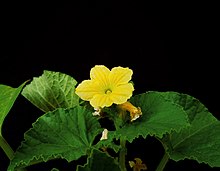| Honeydew melon | |
|---|---|
 | |
| Species | Cucumis melo |
| Cultivar group | Inodorus group |
| Origin | North Africa (Morocco to Egypt), Southern France, Spain |
| Nutritional value per 100 g (3.5 oz) | |||||||||||||||||||||||||||||||||||||||||||||
|---|---|---|---|---|---|---|---|---|---|---|---|---|---|---|---|---|---|---|---|---|---|---|---|---|---|---|---|---|---|---|---|---|---|---|---|---|---|---|---|---|---|---|---|---|---|
| Energy | 150 kJ (36 kcal) | ||||||||||||||||||||||||||||||||||||||||||||
9.09 g | |||||||||||||||||||||||||||||||||||||||||||||
| Sugars | 8.12 g | ||||||||||||||||||||||||||||||||||||||||||||
| Dietary fiber | 0.8 g | ||||||||||||||||||||||||||||||||||||||||||||
0.14 g | |||||||||||||||||||||||||||||||||||||||||||||
0.54 g | |||||||||||||||||||||||||||||||||||||||||||||
| |||||||||||||||||||||||||||||||||||||||||||||
| †Percentages estimated using US recommendations for adults,[1] except for potassium, which is estimated based on expert recommendation from the National Academies.[2] | |||||||||||||||||||||||||||||||||||||||||||||


The honeydew melon is one of the two main cultivar types in Cucumis melo Inodorus Group.[3] It is characterized by the smooth, often green or yellowish rind and lack of musky odor. The other main type in the Inodorus Group is the wrinkle-rind casaba melon.[4]
- ^ United States Food and Drug Administration (2024). "Daily Value on the Nutrition and Supplement Facts Labels". FDA. Archived from the original on 2024-03-27. Retrieved 2024-03-28.
- ^ National Academies of Sciences, Engineering, and Medicine; Health and Medicine Division; Food and Nutrition Board; Committee to Review the Dietary Reference Intakes for Sodium and Potassium (2019). Oria, Maria; Harrison, Meghan; Stallings, Virginia A. (eds.). Dietary Reference Intakes for Sodium and Potassium. The National Academies Collection: Reports funded by National Institutes of Health. Washington, DC: National Academies Press (US). ISBN 978-0-309-48834-1. PMID 30844154. Archived from the original on 2024-05-09. Retrieved 2024-06-21.
- ^ Stephens, James M. (2018-11-01). "Melon, Honeydew—Cucumis melo L. (Inodorus group)". Minor Vegetables Handbook. University of Florida, Institute of Food and Agricultural Sciences Extension. Retrieved 2021-01-25.[permanent dead link]
- ^ Stephens, James M. (2018-11-01). "Melon, Casaba—Cucumis melo L. (Inodorus group)". Minor Vegetables Handbook. University of Florida, Institute of Food and Agricultural Sciences Extension. Archived from the original on 2021-02-12. Retrieved 2021-01-25.